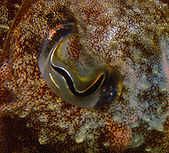- Cephalopod eye
-
Vertebrates and octopuses developed the camera eye independently. In the vertebrate version the nerve fibers pass in front of the retina, and there is a blind spot where the nerves pass through the retina. In the vertebrate example, 4 represents the blind spot, which is notably absent from the octopus eye. In vertebrates, 1 represents the retina and 2 is the nerve fibers, including the optic nerve (3), whereas in the octopus eye, 1 and 2 represent the nerve fibers and retina respectively.
Cephalopods, as active marine predators, possess sensory organs specialized for use in aquatic conditions.[1] They have a camera-type eye, which consists of a lens projecting an image onto a retina. Unlike the vertebrate camera eye, the cephalopods' form as invaginations of the body surface (rather than outgrowths of the brain), and consequently they lack a cornea. Unlike the vertebrate eye, a cephalopod eye is focused through movement, much like the lens of a camera or telescope, rather than changing shape as the lens in the human eye does. The eye is approximately spherical, as is the lens, which is fully internal.[2]
 Eye of Bathyteuthis sp.
Eye of Bathyteuthis sp.
The crystalins used in the lens appear to have developed independently from vertebrate crystalins, suggesting a homoplasious origin of the lens.[3]
Most cephalopods possess complex extraocular muscle systems that allow for very fine control over the gross positioning of the eyes. Octopuses possess an autonomic response that maintains the orientation of their pupils such that they are always horizontal.[1]
Polarized light
It has been documented that several types of cephalopods, most notably squid and octopuses, and potentially cuttlefish, have eyes that can distinguish the orientation of polarized light. This sensitivity is due to the orthogonal organization of neighboring photoreceptors. To illustrate, the vertebrate eye is normally insensitive to polarization differences because visual pigment in rods and cones is arrayed semi-randomly, and is thereby equally sensitive to any orientation of the e-vector axis of the light. Because of their orthogonal organization, the visual pigment molecules in cephalopod eyes have the highest light absorption when aligned properly with the light e-vector axis, allowing sensitivity to differences in polarization.[4] The precise function of this ability has not been proven, but is hypothesized to be for prey detection, navigation, and possibly communication among the color-changing cephalopods.[5] [4]
See also
References
- ^ a b Budelmann BU. "Cephalopod sense organs, nerves and the brain: Adaptations for high performance and life style." Marine and Freshwater Behavior and Physiology. Vol 25, Issue 1-3, Page 13-33.
- ^ Yamamoto, M. (Feb 1985). "Ontogeny of the visual system in the cuttlefish, Sepiella japonica. I. Morphological differentiation of the visual cell". The Journal of Comparative Neurology 232 (3): 347–361. doi:10.1002/cne.902320307. ISSN 0021-9967. PMID 2857734.
- ^ SAMIR K. BRAHMA1 (1978). "Ontogeny of lens crystallins in marine cephalopods". Embryol. Exp. Morph. Vol. 46,pp. 111-118, 46 (1): 111–8. PMID 359745. http://dev.biologists.org/cgi/reprint/46/1/111.pdf.
- ^ a b Mathger, L.M.; Shashar, N.; Hanlon, R.T. (2009). "Do cephalopods communicate using polarized light reflections from their skin?". Journal of Experimental Biology 212: 2133–2140.
- ^ Shashar N, Rutledge P, and Cronin T. "Polarization vision in cuttlefish in a concealed communication channel?" Journal of Experimental Biology, Vol 199, Issue 9 2077-2084

Eyes - Arthropod eye
- Cephalopod eye
- Eye shine
- Gastropod eye
- Human eye
- Simple eye in invertebrates
- Mammalian eye
- Mollusc eye
- Parietal eye
Evolution Colouration - Animal colouration
- Aposematism
- Camouflage
- Chromatophore
- Countershading
- Crypsis
- Eyespot (mimicry)
- Theory of camouflage
- Underwater camouflage and mimicry
Related topics Categories:- Cephalopod zootomy
- Vision by taxon
- Cephalopod stubs
- Eye stubs
Wikimedia Foundation. 2010.





